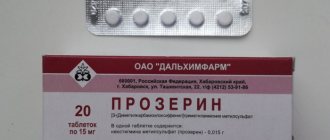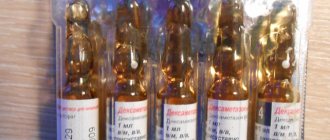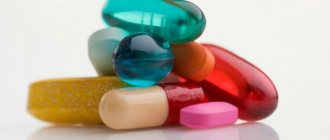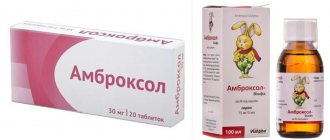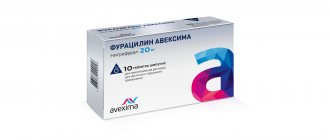Cocarboxylase - mechanism of action, how to take and dosage, contraindications and reviews
· You will need to read: 6 minutes
If the acid-base balance in the body is disturbed, acidosis can occur. This is a serious pathology associated with human metabolic problems. Its consequences may include renal, hepatic, and respiratory failure. To rid a person of the problem of acidification of the body, special coenzyme preparations are used, for example, the drug Cocarboxylase.
Instructions for use of Cocarboxylase
In Latin, the name of the drug sounds like Cocarboxylase, the medication is produced by domestic and foreign manufacturers, and has been known for a long time. The active component of the drug is cocarboxylase hydrochloride, which has coenzyme properties, eliminates the manifestations of acidosis and returns the human body to normal functioning.
Composition and release form
The drug is known only in the format of a lyophilisate - a powder for the preparation of a parenteral solution. Composition and description:
| Description | Homogeneous, finely porous, hygroscopic mass of white color |
| Compound | One ampoule contains 50 mg of cocarboxylase hydrochloride and 2 ml of solvent - sodium acetate |
| Package | Ampoules with powder 50 mg, pack of 5 ampoules |
Pharmacological properties
Cocarboxylase is a coenzyme (an organic compound that plays an important role in the reactions) of thiamine (vitamin B1). In combination with proteins and magnesium ions, it catalyzes (accelerates) the process of carboxylation and decarboxylation of alpha-keto acids and stimulates the formation of acetyl-coenzyme A. This leads to the normalization of carbohydrate metabolism.
The active substance of the drug is quickly and completely absorbed when administered parenterally. Absorption of the component occurs in the small intestine and duodenum; the substance is excreted after 11 hours.
The drug is found in the liver, brain, kidneys, and heart. Red blood cells carry the active component of the drug in the form of thiamine diphosphate. Metabolism of the component occurs in the liver, metabolites are excreted in the urine.
The metabolic effect of the drug occurs due to the activation of tissue metabolism.
Cocarboxylase powder is phosphorylated to form phosphorus esters, promotes the rapid absorption of glucose and normalizes the functioning of the cardiovascular system.
Also, the active component of the composition improves tissue trophism; with a lack of substance, the level of pyruvic and lactic acids in the blood increases, which leads to the development of acidosis and acidotic coma.
Indications for use
The drug is prescribed for diseases associated with endogenous coenzyme deficiency in combination with B vitamins. Indications are:
- metabolic, diabetic, respiratory acidosis;
- cardiac, renal, respiratory failure;
- post-infarction cardiosclerosis;
- disturbances of carbohydrate metabolism against the background of pathological processes;
- myocardial infarction;
- unstable angina;
- chronic ischemic heart disease;
- hepatic, diabetic coma;
- acute alcohol poisoning, chronic alcoholism;
- multiple sclerosis;
- sepsis, pneumonia;
- diseases accompanied by hypoxia and acidosis;
- infectious diseases.
Directions for use and dosage
The drug can be administered subcutaneously, intramuscularly or intravenously. For adults, 50-100 mg/day is indicated; according to the doctor’s decision, a second dose is administered after two hours. For diabetic coma, the maintenance dosage is 50 milligrams/day.
In case of circulatory failure, 50 mg of dissolved substance is administered 2-3 times/day for a course of 2-4 weeks. Patients with diabetes mellitus receive intravenous drips of 100-1000 mg/day for a course of 5-10 days against the background of usual antidiabetic therapy.
For acute liver and kidney failure, Cocarboxylase is administered intravenously at a dosage of 50-150 mg three times a day, or 100-300 mg/day drip in 400 ml of a 5% glucose solution.
For peripheral neuritis, 50-100 mg/day intramuscularly for up to 45 days helps. Newborns up to three months receive intramuscular or subcutaneous injections of a solution at a dose of 25 mg/day.
Up to seven years, 25-50 mg/day is administered, from 8 to 18 years – 50-100 mg/day.
special instructions
Cocarboxylase contains glycocholic acid, which, when administered repeatedly or for a long time to patients with jaundice or cholestasis, can impair liver function. Other special instructions for the drug:
- After diluting the lyophilisate, the solution can be stored for no longer than a day at a temperature of 2-8 degrees, but it is better to use it immediately.
- It is unknown how the drug affects speed and concentration, because the patients receiving treatment were in moderate to severe conditions and were physically unable to drive vehicles and machinery.
Cocarboxylase during pregnancy
Indications for the use of the drug during pregnancy include fetal hypoxia and treatment of toxicosis as part of complex therapy. Pregnant women are prescribed a course of medication for 10 days at 50 mg/day. The lyophilisate is dissolved with 20 ml of glucose, injections are given intravenously in combination with a solution of ascorbic acid (vitamin C).
Drug interactions
It is not recommended to combine the drug with alkaline or neutral solutions. Other drug interactions:
- Antidepressants enhance the effect of Cocarboxylase.
- The drug enhances the effect of B vitamins when used simultaneously.
- Digoxin reduces the ability of myocardiocytes to absorb the active substance of the drug and its metabolites.
Side effects
The development of negative reactions to the drug is possible after administration of a dose of over 500 mg/day. Side effects of the drug include:
- lack of appetite, stomach pain, nausea, atony;
- feelings of anxiety, fear, sleep disturbances;
- ataxia (loss of coordination), lethargy;
- acute respiratory failure;
- allergic reactions: urticaria, itching, skin rash;
- swelling, pain, severe burning at the injection site.
Overdose
If you exceed the prescribed dosage of the drug, you may develop tachycardia, vomiting and nausea, headache, weakness and general fatigue.
A person may experience muscle spasms, shortness of breath, increased sweating, allergic reactions and disruption of the cardiovascular system.
If signs of overdose appear, treatment with the drug is canceled and symptomatic therapy is carried out.
Cocarboxylase contraindications
The drug is used with caution during pregnancy and lactation (breastfeeding). Contraindications for its use are hypersensitivity, individual intolerance or allergy to the constituent components of the medication or its active substance. In this case, the drug is replaced with a safe analogue.
Terms of sale and storage
You can buy the medicine only with a prescription. The drug is stored at temperatures up to 25 degrees in a dry, dark place without access to sunlight for three years from the date of manufacture.
Analogs
There are several popular substitutes for the drug from different manufacturers, but with the same name. Their description:
- Cocarboxylase Improv is a coenzyme obtained in the body from thiamine;
- Cocarboxylase Ferein is a complete analogue of the drug with the same therapeutic effect;
- Ellara cocarboxylase is a metabolic agent in the form of a lyophilisate;
- Cocarboxylase Hydrochloride is a coenzyme that takes part in carbohydrate metabolism.
Cocarboxylase price
The cost of the drug is influenced by the level of the seller’s trade margin and the cost of raw materials from different manufacturers. Approximate prices for medication when purchased through online stores and pharmacies in Moscow will be:
| Manufacturer of ampoules 50 mg with solvent | Price for 1 piece. on the Internet, rubles | Cost for 1 piece. at the pharmacy, rubles |
| Moskhimfarmpreparaty | 47 | 50 |
| Microgen, Tomsk | 26 | 29 |
| Virion | 51 | 55 |
| Bryntsalov | 16 | 18 |
| Microgen, Perm | 180 | 190 |
Reviews
Tatyana, 37 years old
I have type 2 diabetes, so I carefully monitor my glucose levels. A month ago, my sugar dropped significantly, so I had to call an ambulance. The doctors gave me an injection of Cocarboxylase to restore carbohydrate metabolism. This quickly helped eliminate the problem, but I had to take another three-day course to support the body.
Dmitry, 45 years old
I drank vodka for a week, only the development of acute alcohol poisoning stopped me. I couldn’t cope with it on my own, so my wife called the doctors. They took me to the hospital to remove toxins. I was given IV drips that included Cocarboxylase. The drug is effective, after its effects I was quickly released from the hospital.
Daria, 30 years old
During pregnancy with my second child, I had severe toxicosis, and in addition, doctors discovered a threat of fetal hypoxia. To improve the metabolism in the placenta and prevent the baby from suffocating, I was prescribed a course of injections with vitamin C. At the same time, Cocarboxylase was included. The effect was obvious - the child was born healthy, without any abnormalities.
Alexander, 54 years old
I suffered a myocardial infarction. If it weren’t for the competent actions of the emergency doctors, I would not have survived. They told my wife and I that I had developed acute heart failure and had to be quickly given the drug Cocarboxylase. It helped stop the development of the deadly process and normalized metabolism. I'm slowly recovering.
The information presented in the article is for informational purposes only. The materials in the article do not encourage self-treatment. Only a qualified doctor can make a diagnosis and make recommendations for treatment based on the individual characteristics of a particular patient.
Source
Source: https://03-med.info/lekarstva/kokarboksilaza-mekhanizm-deystviya-ka.html
Dosage and features of administration of Cocarboxylase
After dilution, the drug is injected into a muscle, into a vein or subcutaneously. Dosages for adults are determined by the nature of the pathology:
- For heart disease and circulatory failure, different amounts of the drug - from 50 to 100 milligrams. Injections are given intramuscularly 2-3 times a day for 15-30 days.
- Patients with diabetes mellitus require 100-1000 milligrams per day. The medicine is administered intravenously.
- In case of acute liver and kidney failure, Cocarboxylase is administered intravenously up to 3 times a day, 50-150 mg. A single drop of administration is possible.
- For peripheral neuritis, the daily dosage is from 50 to 100 mg. The injection is given once a day for one to one and a half months.
Cocarboxylase - mechanism of action, how to take and dosage, contraindications and reviews
If the acid-base balance in the body is disturbed, acidosis may occur. This is a serious pathology associated with human metabolic problems. Its consequences may include renal, hepatic, and respiratory failure. To rid a person of the problem of acidification of the body, special coenzyme preparations are used, for example, the drug Cocarboxylase.
In Latin, the name of the drug sounds like Cocarboxylase, the medication is produced by domestic and foreign manufacturers, and has been known for a long time. The active component of the drug is cocarboxylase hydrochloride, which has coenzyme properties, eliminates the manifestations of acidosis and returns the human body to normal functioning.
The drug is known only in the format of a lyophilisate - a powder for the preparation of a parenteral solution. Composition and description:
| Description | Homogeneous, finely porous, hygroscopic mass of white color |
| Compound | One ampoule contains 50 mg of cocarboxylase hydrochloride and 2 ml of solvent - sodium acetate |
| Package | Ampoules with powder 50 mg, pack of 5 ampoules |
Side effects
Cocarboxylase has side effects on the body after administration of a dose exceeding 500 mg per day. Side effects occur in the form of the following reactions:
- lack of appetite;
- pain in the epigastric region;
- nausea
; - feelings of anxiety and fear;
- ataxia;
- lethargy;
- acute respiratory failure;
- skin rash;
Side effects may also occur in the area where the drug is administered in the form of:
- swelling;
- pain;
- strong burning sensation.
Cocarboxylase
Cocarboxylase is a vitamin-like drug that improves glucose absorption, trophism of nervous tissue, and helps normalize the functioning of the cardiovascular system.
Release form and composition
The following dosage forms of Cocarboxylase are produced:
- Powder for the preparation of solution for injection (in ampoules of 0.05 g, complete with solvent - sodium acetate solution in ampoules of 2 ml, in packs of 3 sets);
- Lyophilisate for preparing a solution for intramuscular administration (in ampoules of 0.05 g, complete with solvent - water for injection in ampoules of 2 ml, in packages of 5 sets);
- Lyophilisate for the preparation of a solution for intravenous and intramuscular administration (in ampoules of 0.025 and 0.05 g, complete with solvent - water for injection in ampoules of 2 ml, or without it, in cardboard packs of 10 ampoules, 5, 10 or 20 sets ).
Active ingredient: cocarboxylase:
- 1 ampoule with powder – 0.05 g;
- 1 ampoule with lyophilisate for intramuscular administration – 0.05 g;
- 1 ampoule with lyophilisate for intravenous and intramuscular administration – 0.025 and 0.05 g.
Contraindications
Hypersensitivity to cocarboxylase.
Terms and conditions of storage
Store in a dry place, protected from light and out of reach of children. Powder - at a temperature not exceeding 25 °C, lyophilisate for preparing a solution for intravenous and intramuscular administration - 20 °C, lyophilisate for preparing a solution for intramuscular administration - 10 °C.
Shelf life – 3 years.
Source: https://medlib.net/kokarboksilaza.html
Cocarboxylase and ATP
Cocarboxylase is often prescribed in combination with ATP. Injections of these medications are alternated every other day. ATP is Adenosine Triphosphoric Acid. Its use has several effects:
- normalizes contraction and relaxation of the myocardium;
- improves impulse transmission along nerve fibers;
- improves blood supply to the heart and brain;
- increases the body's endurance.
Thus, the combination of ATP and Cocarboxylase is used mainly for the treatment of chronic cardiovascular pathologies. The feasibility of such complex treatment has not been confirmed by clinical trials.
Cocarboxylase Forte 50 mg tablets No. 30
active ingredient: 1 tablet contains: thiamine pyrophosphate chloride aminoacetate-magnesium (II) potassium salt trihydrate in terms of 100% substance 25 mg or 50 mg; excipients: lactose, monohydrate; microcrystalline cellulose; powdered sugar; calcium stearate.
Dosage form
Tablets. Tablets are white, round in shape with a biconvex surface and with a dash on one side.
Pharmacotherapeutic group
Simple preparations of vitamin B1. ATC code A11D A.
Thiamine pyrophosphate chloride amino acetate magnesium (II) potassium salt trihydrate is the original coordination compound of cocarboxylase (thiamine pyrophosphate hydrochloride). The presence of magnesium ions and the amino acid glycine in the compound is accompanied by an increase in the activity of cocarboxylase relative to the enzymes of carbohydrate metabolism, for which it is a coenzyme.
In the body, cocarboxylase, in combination with protein and magnesium ions, is an integral part of the carboxylase enzyme, which catalyzes the decarboxylation and carboxylation of a-keto acids. Cocarboxylase activates the main enzymes of carbohydrate metabolism, which is accompanied by increased utilization of glucose by tissues.
Increased glucose metabolism leads to activation of tissue respiration, increased ATP production and reduced accumulation of lactic acid. This effect is accompanied by an improvement in metabolic processes, especially in diabetes mellitus.
Cocarboxylase promotes more complete utilization of pyruvic acid, which is accompanied by an improvement in the function of nerve fibers in diabetes mellitus and a decrease in neuropathy.
Cocarboxylase-Forte helps normalize cell metabolism under conditions of ischemia and hypoxia. The use of the drug in conditions associated with the activation of free radical reactions is accompanied by an improvement in antioxidant status.
After sublingual (sublingual) administration, the components of the drug are quickly absorbed into the blood. The maximum concentration in blood plasma is determined after 0.5-1.5 hours. Metabolic products are excreted by the kidneys.
Proper safety precautions for use
When using Cocarboxylase-Forte, patients with diabetes need to monitor their blood glucose levels.
Special Cautions
Use during pregnancy or breastfeeding.
The effectiveness and safety of the use of cocarboxylase hydrochloride during pregnancy or breastfeeding have not been established, so the drug is not recommended for use during this period.
Children
The effectiveness and safety of using Cocarboxylase-Forte in children under 12 years of age have not been studied, so the drug is not recommended for use in this age category of patients.
Directions for use and doses
In each case, the method and dose of the drug are determined by the doctor.
Adults and children over 12 years of age usually take the tablets under the tongue, holding them in the mouth until completely absorbed, 3-4 times a day. It is also possible to take the drug orally 10-15 minutes before eating, 3-4 times a day. The duration of treatment is usually 20-30 days.
Side effects
The drug is well tolerated, side effects are very rare. In some cases, in persons with increased individual sensitivity to the components of the drug, allergic reactions (urticaria, skin rash, itching) may develop when using it. In this case, the dose is reduced or the drug is discontinued. After discontinuation of the drug, all side effects quickly disappear.
Interaction with other drugs and other types of interactions
When using Cocarboxylase-Forte simultaneously with hypoglycemic agents, it is necessary to take into account the increase in their activity.
Cocarboxylase enhances the cardiotonic effect of cardiac glycosides and improves their tolerability.
Storage conditions
Store in original packaging at a temperature not exceeding +15 ° C. Keep out of the reach of children.
Package
10 tablets in a blister; 3 blisters per box.
Vacation category
Over the counter.
Source: https://arrhythmia.center/medicines/kokarboksilaza-forte-50-mg-tabletki-30/
Cocarboxylase price
The price of Cocarboxylase depends on the form of release and the pharmaceutical plant producing the drug under a license obtained from the official manufacturer. Sample list of prices for Cocarboxylase:
- in ampoules of 50 mg N1 with MCFP solvent produced by Moskhimfarmpreparaty OJSC - costs 47.00 rubles;
- in ampoules of 50 mg N1 with a solvent produced by Microgen NPO FSUE Tomsk, Virion - costs 26.30 rubles;
- in ampoules of 50 mg N1 with a solvent produced by MHFP - costs 50.30 rubles;
- in ampoules of 50 mg N1 with solvent produced by Bryntsalov A - costs 15.60 rubles;
- in ampoules of 50 mg N1 with solvent produced by Moskhimfarmpreparaty (Russia) - costs 7.30 rubles;
- in ampoules 50 mg N1 with solvent produced by Microgen NPO FSUE Perm, Biomed - costs 180.00 rubles.
- Online pharmacies in RussiaRussia
- Online pharmacies in UkraineUkraine
- Online pharmacies in KazakhstanKazakhstan
WER.RU
Europharm* 4% discount using promo code medside11
Pharmacy Dialogue* discount 100 rub. using promo code medside (for orders over 1000 rubles)
- Cocarboxylase (amp. 50 mg No. 5 + solution)
- Cocarboxylase (amp. 50 mg No. 5 + solution)
- Cocarboxylase (amp. 50 mg No. 5 + solution)
- Cocarboxylase (amp. 50 mg No. 5 + solution)
- Cocarboxylase (amp. 50 mg No. 5 + solution)
Pharmacy24
- Cocarboxylase-forte 50 mg No. 30 tablets TOV Astrapharm, Ukraine
PaniPharmacy
- Cocarboxylase por. d/in. 50mg amp. No. 10 b/sol. Ukraine, Biopharma CJSC
- Cocarboxylase por. d/in. 50mg amp. No. 10 with solution Ukraine, Biopharma CJSC
- Cocarboxylase forte tablets Cocarboxylase-forte tablets. 50 mg No. 30 Ukraine, Astrapharm LLC
BIOSPHERE
- Cocarboxylase 50 mg No. 5 por.liof.d/in. Microgen FSUE NPO (Russia)
- Cocarboxylase 50 mg No. 10 por.liof.d/in.Biopharma (Ukraine)
NOTE! Information about medications on the site is for reference and general information, collected from publicly available sources and cannot serve as a basis for making a decision on the use of medications in the course of treatment. Before using the drug Cocarboxylase, be sure to consult with your doctor.
Source: medside.ru
Cocarboxylase, indications for use, reviews and instructions
The use of Cocarboxylase reduces the concentration of pyruvic and lactic acid, improves glucose processing, has a positive effect on the trophism of nerve tissue, and normalizes the functionality of the cardiovascular system. If the body is deficient in this substance, the level of pyruvic acid in the blood increases, which can lead to the development of acidosis.
Overdose and side effects
- Symptomatic treatment is carried out aimed at stabilizing cardiovascular activity and respiratory rhythm.
- Discontinuation of the drug.
As a rule, an overdose does not occur.
- Skin itching, urticaria and other allergic reactions
- In the case of intramuscular injection, there is swelling and itching at the injection site.
Analogs
- “Ferein cocarboxylase.”
- “Improv cocarboxylase.”
- “Hydrochloride cocarboxylase.”
- “Ellara cocarboxylase.”
All drugs have exactly the same active ingredient and release form.
Cocarboxylase and ATP
- Therapy of tuberculosis in children of early and adolescent age. Doctors often classify drugs that stimulate energy metabolism as pathogenetic therapy.
Scientific research has established that under the influence of tuberculosis intoxication or in oncology in the case of long-term chemotherapy, unfavorable changes develop in energy metabolic processes, in particular in the heart muscle.With the development of pulmonary tuberculosis, hypoxia occurs, which leads to increased anaerobic glycolysis.As a result, under-oxidized products accumulate, so it is advisable to use cocarboxylase and ATP in the complex treatment of patients.
- The drug has a positive effect on internal metabolic processes and has a beneficial effect on myocardial trophism.
When anti-tuberculosis drugs are combined with cocarboxylase and ATP, the symptoms of intoxication disappear much faster. The course is usually formed by 10-15 injections, depending on the severity of the disease. - For multiple sclerosis, alternating injections of cocarboxylase and ATP becomes part of complex therapy.
A cardiovascular drug, the main active ingredient of which is called cocarboxylase. In the human body, “Cocarboxylase” is formed from Thiamine and takes part in carbohydrate and fat metabolism. Promotes the synthesis of acetyl-coenzyme A.
Reviews:
Maria Mikhailovna 33 years old
I had very severe and debilitating toxicosis, my weight dropped by 6 kg, the doctor considered it necessary to prescribe cocarboxylase. The drug was administered intravenously and the suffering was alleviated after ten injections. Then a healthy baby was born.
Victor Fedorovich 47 years old
I was prescribed the drug after suffering a cardiovascular disease. No significant changes were noticed, but the doctor said that positive dynamics were emerging.
Reviews from doctors:
Cocarboxylase helps regulate metabolism, which can have a positive effect on weight normalization.
According to some data, vitamin B1 promotes the production of endomorphins in the body. These substances are produced in the brain and relieve pain in the body.
Whether or not to use cocarboxylase as a component of treatment must be discussed with the doctor taking medical history. In some cases, the prescription has a “placebo” effect. If your doctor prescribes a full course of injections, you should be prepared for the fact that cocarboxylase injections are quite painful.
Cocarboxylase contains mainly Vitamin B1, in this video experts will tell us about the benefits of this vitamin and how to use it:
Source: https://provitaminki.com/spravochnik/kokarboksilaza-pokazaniya.html
Benefits of cocarboxylase
Cocarboxylase is a ready-made form of the enzyme that is involved in important vital functions of the body, although not all properties coincide with the functions of vitamin B1.
The main feature of cocarboxylase is the complete absorption of the drug in a fairly short period of time, but in the case when it is administered parenterally. Due to the speed of action, the active substance penetrates into all tissues, and its greatest concentration is in the liver, brain and heart. Red blood cells transport the drug into the blood in the form of thiamine diphosphate, and the metabolism of the active substance occurs in the liver. The drug is completely excreted from the body along with urine.
It is known that cocarboxylase is recognized as the active form of vitamin B1. Due to the activation of tissue metabolism, the metabolic effect of this substance occurs. The drug takes an active part in the carboxylation and decarboxylation of alpha-keto acids. Its main advantages include improving the processes of carbohydrate metabolism, glucose absorption, reducing the level of pyruvic acid, as well as normalizing the restoration of tissues of the central and peripheral nervous system. After taking cocarboxylase, patients experience increased functionality of the cardiovascular system.
It is important to note that since the drug is a thiamine derivative, it is not suitable for the treatment of hypovitaminosis and vitamin B1 deficiency. The drug is completely excreted from the body in the urine, without being metabolized by the kidneys.
Cocarboxylase is used in the complex treatment of diseases associated with vitamin B1 deficiency and to improve carbohydrate metabolism. An insufficient level of cocarboxylase in the body can provoke the development of acytosis pathology, which can subsequently affect the normal functioning of all internal organs, which can subsequently lead to death.
List of pathologies for which taking cocarboxylase is recommended: acidosis; heart and pulmonary failure; chronic heart and vascular diseases; with ischemia, including in pre-infarction conditions; liver and kidney failure; with chronic alcoholism; in case of intoxication of the body; for acute viral infections; for pathologies of the nervous system; if the brain of a newborn is affected and this is associated with oxygen starvation; for disorders associated with hydrocarbon metabolism.
Harm from using cocarboxylase
There are no contraindications to the use of the drug, only if a person has an allergic reaction to the substance. However, if you do not follow the instructions for taking the drug, the following symptoms of overdose may appear: nausea, weakness, muscle cramps, increased sweating, heart rhythm disturbances, headaches, fatigue and shortness of breath, Quincke's edema and hypertension.
Cocarboxylase is not prescribed for the treatment of pathologies associated with vitamin B1 deficiency.
If health problems occur due to an overdose of the drug, treatment is carried out aimed at ensuring the normal functioning of the heart muscle and lungs.
What does Cocarboxylase do: instructions for use
Cocarboxylase is a drug that improves energy supply and tissue metabolism.
The use of the medication allows you to reduce the concentration of pyruvic and lactic acid, improves the processing of glucose, has a positive effect on the trophism of nerve tissue, and normalizes the functionality of the cardiovascular system. If the body is deficient in this substance, the level of pyruvic acid in the blood increases, which can lead to the development of acidosis.
On this page you will find all the information about Cocarboxylase: complete instructions for use for this drug, average prices in pharmacies, complete and incomplete analogues of the drug, as well as reviews of people who have already used Cocarboxylase injections. Would you like to leave your opinion? Please write in the comments.
Clinical and pharmacological group
A coenzyme produced in the body from thiamine.
Conditions for dispensing from pharmacies
Dispensed with a doctor's prescription.
Prices
How much does Cocarboxylase cost? The average price in pharmacies is 125 rubles.
Pharmacological effect
A coenzyme produced in the body from thiamine. Has a metabolic effect, activates tissue metabolism.
In the body it is phosphorylated to form mono-, di- and triphosphoric esters; cocarboxylase is part of enzymes that catalyze the carboxylation and decarboxylation of keto acids, pyruvic acid, and promotes the formation of acetyl coenzyme A, which determines its participation in carbohydrate metabolism. Participation in the pentose cycle indirectly promotes the synthesis of nucleic acids, proteins and lipids. Improves the absorption of glucose, trophism of nervous tissue, and helps normalize the functions of the cardiovascular system.
Cocarboxylase deficiency causes an increase in the level of pyruvic and lactic acids in the blood, which leads to acidosis and acidotic coma.
Use during pregnancy and lactation
Cocarboxylase may be prescribed during pregnancy if the expected benefit to the woman significantly outweighs the potential risks to the child. If it is necessary to use the drug during lactation, you should consult a specialist and decide whether to interrupt breastfeeding of the baby.
Cocarboxylase during pregnancy, if pathologies in the development of the fetus are observed, is strictly prohibited.
Instructions for use
The instructions for use indicate that before use the lyophilisate must be dissolved in water for injection.
Typically, adults are administered intramuscularly or intravenously at a dose of 50-200 mg/day. For diabetes mellitus, the daily dose can be 0.1-1 g. The frequency and duration of use depends on the indications.
For children - intramuscularly, intravenously (drip or stream), for newborns - sublingually. Children under 3 months - 25 mg/day, from 4 months to 7 years - 25-50 mg/day, from 8 to 18 years - 50-100 mg/day. The duration of treatment is from 3-7 to 15 days.
Indications for use
Indications for use of Cocarboxylase are described in detail in the instructions. The main purpose of prescribing the drug is to normalize the function of internal organs, the functioning of which is impaired due to deterioration of metabolism. The medicine is prescribed in the following cases:
- For diabetes mellitus to prevent tissue acidification
. Diabetes can cause the accumulation of lactic and pyruvic acids in tissues, which leads to the development of complications. - With an increase in carbon monoxide in the blood
. An increase in CO2 levels is characteristic of pathologies occurring with respiratory failure. - Patients with coma and precoma
. Cocarboxylase is included in the complex treatment of hepatic, septic, diabetic coma. - In case of alcohol poisoning
. The drug is often prescribed to patients with chronic alcoholism. - Patients with drug poisoning
. Cocarboxylase reduces the toxic effects of cardiac glycosides and barbiturates. - For renal and liver failure
. The medicine, by improving tissue, helps restore organ function. - Patients with neurological diseases
. Cocarboxylase is suitable for the treatment of peripheral neuritis, neuralgia, and mild forms of multiple sclerosis.
Newborns may need the drug for pneumonia, hypoxic encephalopathy, sepsis, and respiratory failure.
Treatment with Cocarboxylase is most often carried out in combination with other medications.
Why is Cocarboxylase prescribed to pregnant women? Medication support may be necessary both in the first weeks after conception and just before childbirth. Normalization of metabolism reduces the risk of placental abruption, premature birth, and reduces the likelihood of developing gestosis in the 3rd trimester. Using the medicine reduces the risk of having a low birth weight baby. Dosage during pregnancy is calculated based on the severity of the detected disorders.
Compound
active ingredient:
cocarboxylase;
1 tablet contains thiamine pyrophosphate chloride aminoacetate-magnesium (II) potassium salt trihydrate in terms of 100% substance 25 mg or 50 mg;
Excipients:
lactose, monohydrate; microcrystalline cellulose; powdered sugar; calcium stearate.
Dosage form.
Pills.
Basic physical and chemical properties:
tablets are white, round in shape with a biconvex surface and scored on one side.
Pharmacotherapeutic group.
Simple preparations of vitamin B1. ATX code A11D A.

